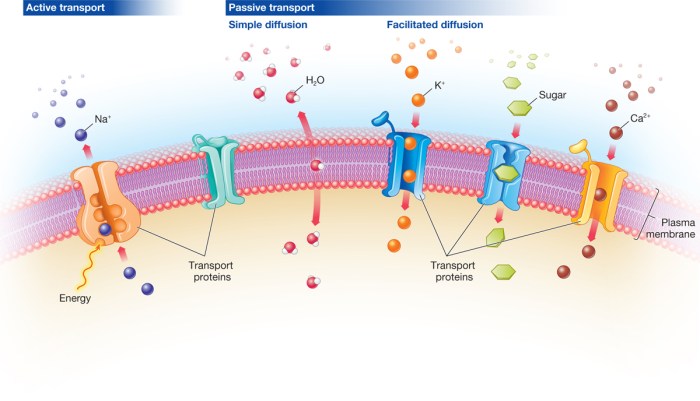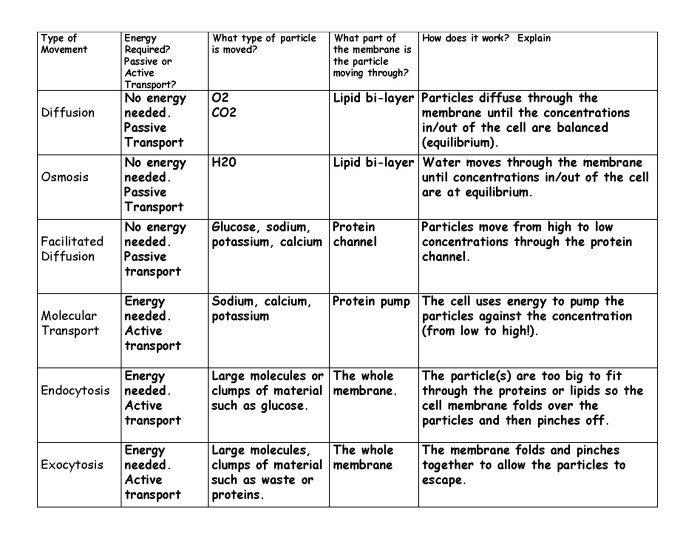Introducing the cell membrane and transport graphic, a visual guide to understanding the intricate mechanisms that govern the movement of substances across cell membranes. This graphic not only unveils the structure and function of the cell membrane but also delves into the dynamics of passive and active transport, facilitated diffusion, and endocytosis/exocytosis.
Prepare to embark on a journey through the world of cell membrane transport, where you’ll discover the role of concentration gradients, energy requirements, and carrier proteins in facilitating the vital exchange of molecules essential for cell survival and function.
Cell Membrane Structure and Function: Cell Membrane And Transport Graphic

The cell membrane, also known as the plasma membrane, is a thin, flexible layer that surrounds the cell and separates it from its surroundings. It is composed of a phospholipid bilayer, a double layer of phospholipids, with embedded proteins.
The phospholipid bilayer is made up of two layers of phospholipids, which are molecules with a hydrophilic (water-loving) head and a hydrophobic (water-hating) tail. The hydrophilic heads face outward, while the hydrophobic tails face inward, forming a barrier to water-soluble molecules.
The embedded proteins are embedded in the phospholipid bilayer and perform a variety of functions, including regulating the movement of substances into and out of the cell, maintaining the cell’s shape, and transmitting signals between cells.
Passive Transport
Passive transport is the movement of molecules across a cell membrane from an area of high concentration to an area of low concentration, without the use of energy. There are two main types of passive transport: diffusion and osmosis.
Diffusion is the movement of molecules from an area of high concentration to an area of low concentration, down a concentration gradient. Osmosis is the movement of water across a semipermeable membrane, from an area of high water concentration to an area of low water concentration, down a water concentration gradient.
Active Transport
Active transport is the movement of molecules across a cell membrane from an area of low concentration to an area of high concentration, against a concentration gradient. Active transport requires energy, which is provided by ATP.
The sodium-potassium pump is an example of active transport. The sodium-potassium pump uses energy to pump sodium ions out of the cell and potassium ions into the cell, maintaining a high concentration of sodium ions outside the cell and a high concentration of potassium ions inside the cell.
Transport Across the Cell Membrane
The cell membrane is selectively permeable, meaning that it allows some molecules to pass through it more easily than others. The rate of transport across the cell membrane depends on the size, charge, and solubility of the molecule.
Small, uncharged molecules, such as water and oxygen, can pass through the cell membrane easily. Large, charged molecules, such as proteins and DNA, cannot pass through the cell membrane easily.
Facilitated Diffusion, Cell membrane and transport graphic
Facilitated diffusion is a type of passive transport that uses carrier proteins to move molecules across the cell membrane. Carrier proteins are embedded in the cell membrane and bind to specific molecules, allowing them to pass through the membrane.
The transport of glucose across the cell membrane is an example of facilitated diffusion. Glucose is a large, charged molecule that cannot pass through the cell membrane easily. However, glucose can bind to carrier proteins, which allow it to pass through the membrane.
Endocytosis and Exocytosis
Endocytosis is the process by which cells take in material from their surroundings. There are two main types of endocytosis: phagocytosis and pinocytosis.
Phagocytosis is the process by which cells take in large particles, such as bacteria and cell debris. Pinocytosis is the process by which cells take in small particles, such as water and nutrients.
Exocytosis is the process by which cells release material from their surroundings. Exocytosis is used to release waste products, hormones, and neurotransmitters.
Membrane Potential
Membrane potential is the difference in electrical charge between the inside and outside of a cell. Membrane potential is generated by the uneven distribution of ions across the cell membrane.
Ion channels and pumps are embedded in the cell membrane and regulate the movement of ions across the membrane. Ion channels are pores that allow ions to pass through the membrane, while ion pumps use energy to pump ions across the membrane.
Membrane potential is important for cell function. It is used to transmit signals between cells, regulate the activity of enzymes, and maintain the cell’s shape.
Answers to Common Questions
What is the primary function of the cell membrane?
The cell membrane acts as a selective barrier, regulating the movement of substances into and out of the cell while maintaining its structural integrity.
Explain the difference between passive and active transport.
Passive transport involves the movement of molecules down a concentration gradient without energy input, while active transport requires energy to move molecules against a concentration gradient.
What is the role of carrier proteins in facilitated diffusion?
Carrier proteins bind to specific molecules and facilitate their transport across the cell membrane, increasing the rate of movement.
How does endocytosis differ from exocytosis?
Endocytosis involves the inward movement of substances into the cell by engulfing them, while exocytosis releases substances from the cell by fusing vesicles with the cell membrane.
What is membrane potential and how is it generated?
Membrane potential is the difference in electrical charge across the cell membrane, generated by the unequal distribution of ions and the activity of ion channels and pumps.
